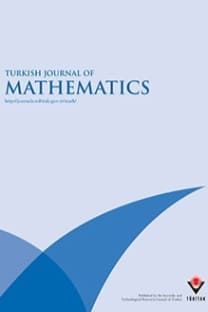On the Qualitative Analysis of the Uniqueness of the Movement of Endothelial Cells
Existence; uniqueness; tumor angiogenesis; steady-state solution; transition probability density function.
On the Qualitative Analysis of the Uniqueness of the Movement of Endothelial Cells
___
- Bellomo, N., Li, N.K., Maini, P.K., On the foundations of cancer modelling: Selected topics, speculations, and perspectives, Math. Mod. Math. Appl. S. 18(4), 593-646 (2008).
- Davis, B., Reinforced random walks, Probal. Theory Related Fields 84, 203-229 (1990).
- Farlow, S., Partial Differential Equations for Scientists and Engineering, Dover, 1993.
- Folkman, J., Tumor angiogenesis: therapeutic implications, New Engl. J. Med 285, 1182-1186 (1971).
- Folkman, J., The vascularization of tumors, Sci. Am., 234, 59-73 (1976).
- Gunzburger, M. D., Peterson, J. S., Finite Element Methods, Iowa State Univ., Iowa, 1998.
- Levine, H. A., Pamuk, S., Sleeman, B. D. , Nilsen-Hamilton, M., Mathematical modeling of capillary formation and development in tumor angiogenesis: Penetration into the stroma, Bull. Math. Biol. 63(5), 801–863 (2001).
- Nicosia, R. F., Bonanno, E., Smith, M., Fibronectin promotes the elongation of microvessels during angiogenesis in vitro, Journal of cellular physiology. 154, 654-661 (1993).
- Othmer, H. G., Stevens, A., Aggregation, blowup, and collapse: The ABC’s of taxis in reinforced random walks, SIAM J. Appl. Math. 57(4), 1044-1081 (1997).
- Pamuk, S., Erdem, A., The method of lines for the numerical solution of a mathematical model for capillary formation: The role of endothelial cells in the capillary, Appl. Math. Comput. 186, 831-835 (2007).
- Pamuk, S., Qualitative Analysis of a Mathematical Model for Capillary Formation in Tumor Angiogenesis, Math. Mod. Meth. Appl. Sci. 13(1), 19 33 (2003).
- Pamuk, S., Steady State Analysis of a Mathematical Model for Capillary Network Formation in the Absence of Tumor Source, Math. Biosci. 189(1), 2138 (2004).
- Paweletz, N., Knierim, M., Tumor-related angiogenesis, Crit. Rev. Oncology/Hematology. 9, 197-243 (1989).
- Yamada, K. M., Olden, K., Fibronectins - adhesive glycoproteins of cell surface and blood, Nature. 275, 179-184 (1978). Erdem ALTUNTAC¸
- Department of Mathematics, University of Kocaeli Umuttepe Campus, 41800, Kocaeli-TURKEY e-mail: erdemath@gmail.com Serdal PAMUK
- Department of Mathematics, University of Kocaeli Umuttepe Campus, 41800, Kocaeli-TURKEY e-mail: spamuk@kocaeli.edu.tr
- ISSN: 1300-0098
- Yayın Aralığı: 6
- Yayıncı: TÜBİTAK
Notes on null curves in Minkowski spaces
Some properties of C-fusion frames
Mohammad Hasan FAROUGHI, Reza AHMADI
On the Qualitative Analysis of the Uniqueness of the Movement of Endothelial Cells
Warped product semi-slant submanifolds in Kenmotsu manifolds
The linear functionals on fundamental locally multiplicative topological algebras
When $delta$-semiperfect rings are semiperfect
Engin BÜYÜKAŞIK, Christian LOMP
Injective simplicial maps of the arc complex
Some sufficient conditions for starlikeness and convexity
Mamoru NUNOKAWA, Shigeyoshi OWA, Yaşar POLATOĞLU, Emel Yavuz DUMAN, Mert ÇAĞLAR
On the codifferential of the Kähler form and cosymplectic metrics on maximal flag manifolds
